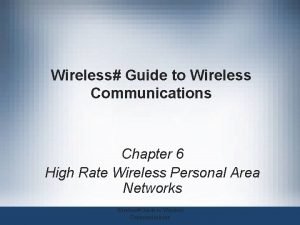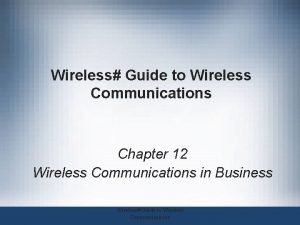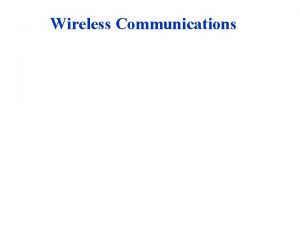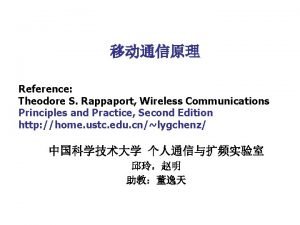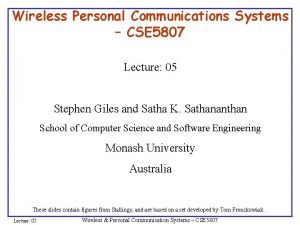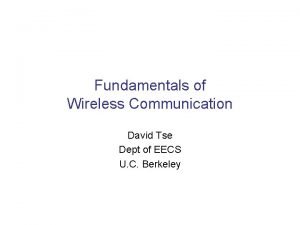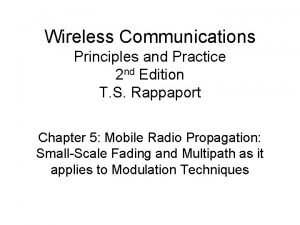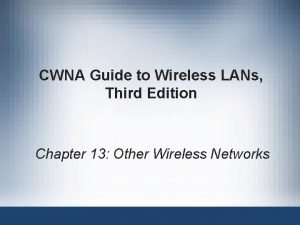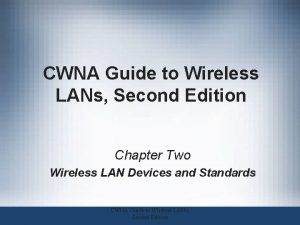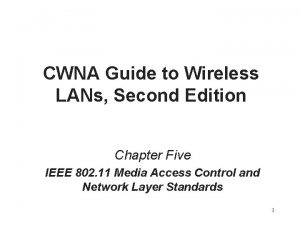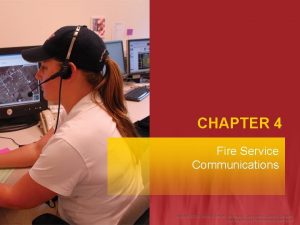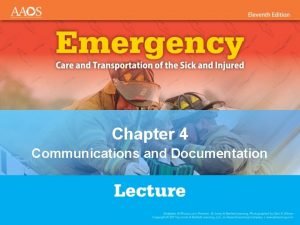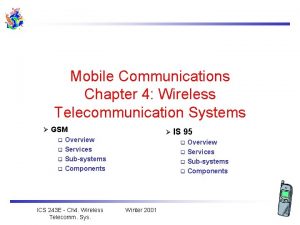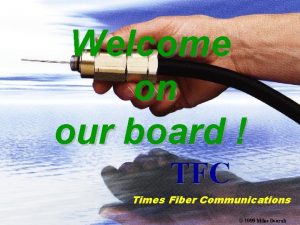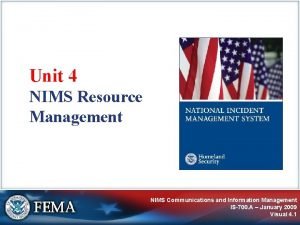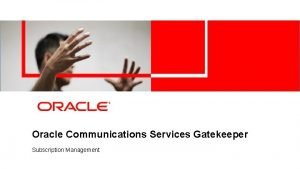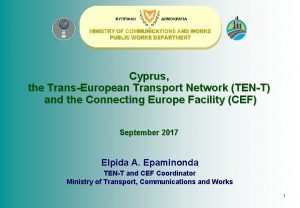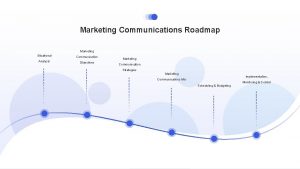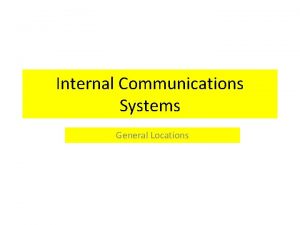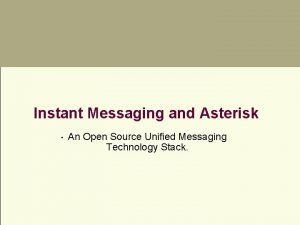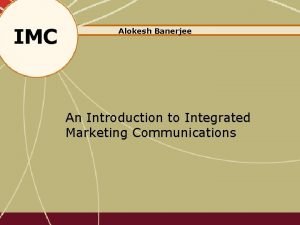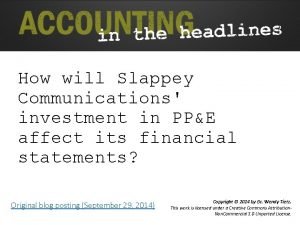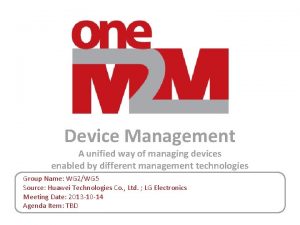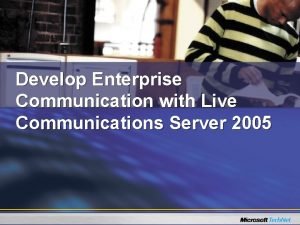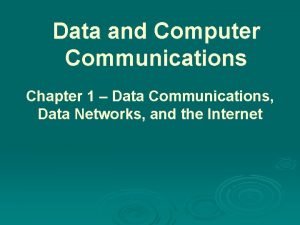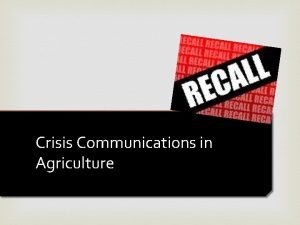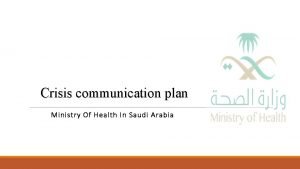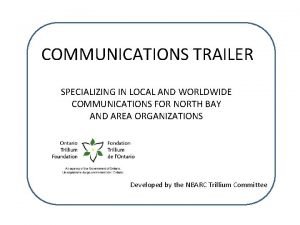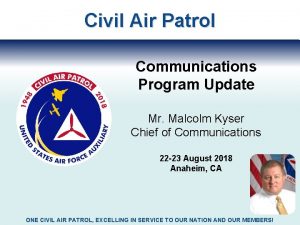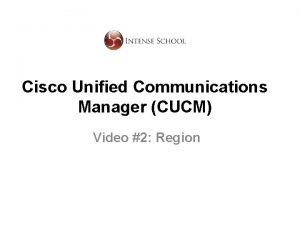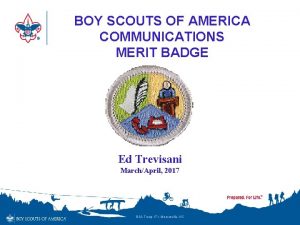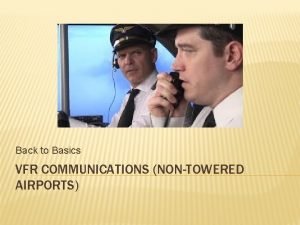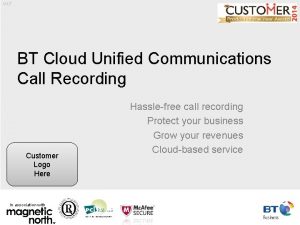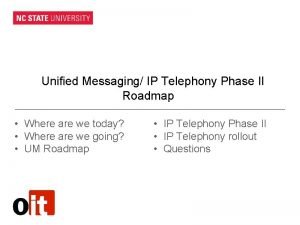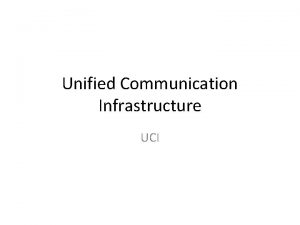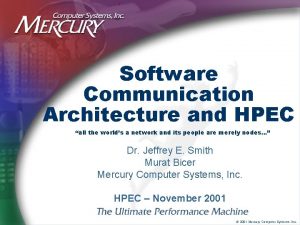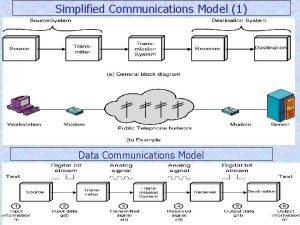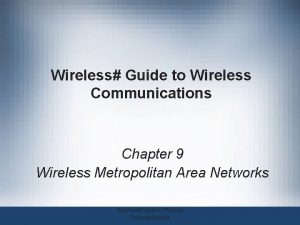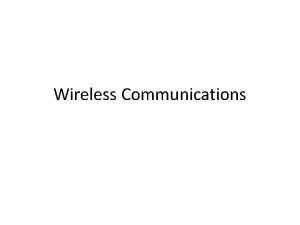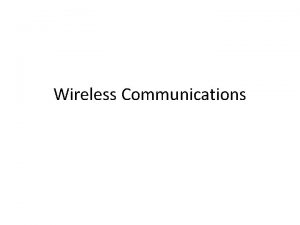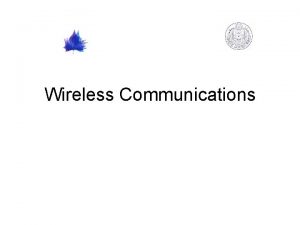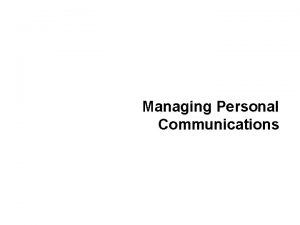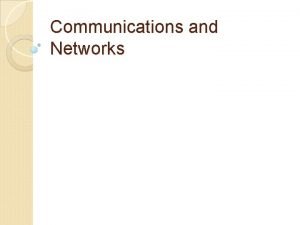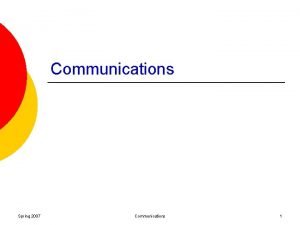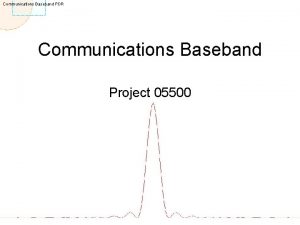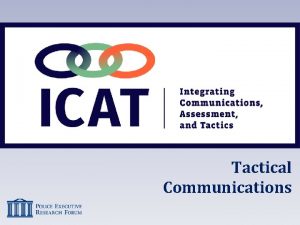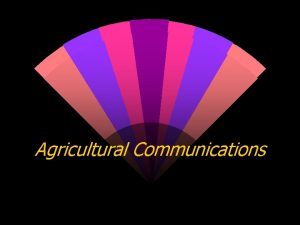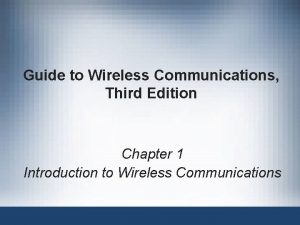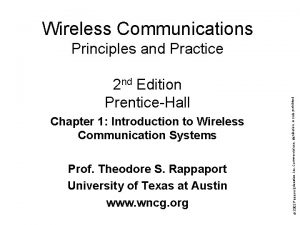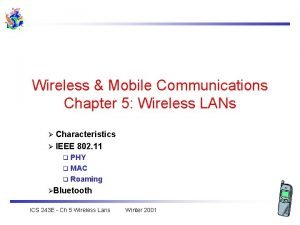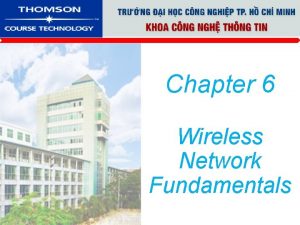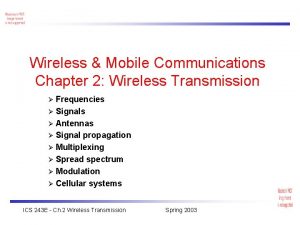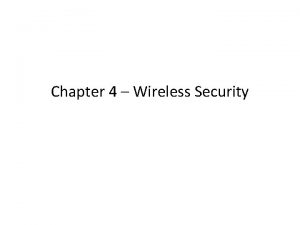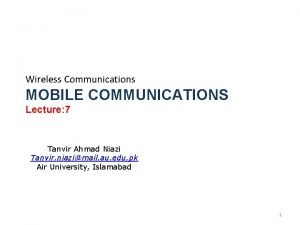Wireless Guide to Wireless Communications Chapter 10 Wireless



































































- Slides: 67

Wireless# Guide to Wireless Communications Chapter 10 Wireless Wide Area Networks Wireless# Guide to Wireless Communications

Objectives • Describe wireless wide area networks (WWANs) and how they are used • Describe the applications that can be used on a digital cellular telephone • Explain how cellular telephony functions • List features of the various generations of cellular telephony • Discuss how satellite transmissions work Wireless# Guide to Wireless Communications 2

Cellular Telephone Applications • Digital cellular telephones can be used to: – – – – – Browse the Internet Send and receive short messages and e-mails Participate in videoconferencing Receive various sorts of information Run a variety of business applications Connect to corporate networks Watch television or on-demand movies Take and transmit pictures and short movies Locate family members and employees using GPS Wireless# Guide to Wireless Communications 3

Cellular Telephone Applications (continued) • Short Message Services (SMS) – One of the most widely used applications – Allows for the delivery of short, text-based messages between wireless devices • Messages are limited to about 160 characters – Applications • • • Person-to-person Agent-to-person Information broadcast services Software configuration Advertising Wireless# Guide to Wireless Communications 4

How Cellular Telephony Works • Keys to cellular telephone networks – Cells • City cells measure approximately 10 square miles • At the center of each cell is a cell transmitter connected to a base station • Each base station is connected to a mobile telecommunications switching office (MTSO) – Link between the cellular network and the wired telephone world – Controls all transmitters and base stations Wireless# Guide to Wireless Communications 5

How Cellular Telephony Works (continued) Wireless# Guide to Wireless Communications 6

How Cellular Telephony Works (continued) • Keys to cellular telephone networks (continued) – Transmitters and cell phones operate at low power • Enables the signal to stay confined to the cell • Signal at a specific frequency does not go far beyond the cell area – Same frequency can be used in other cells at the same time – Except in adjacent cells • Cell phones have special codes Wireless# Guide to Wireless Communications 7

How Cellular Telephony Works (continued) Wireless# Guide to Wireless Communications 8

How Cellular Telephony Works (continued) Wireless# Guide to Wireless Communications 9

How Cellular Telephony Works (continued) • When user moves within the same cell – Transmitter and base station for that cell handle all of the transmissions • As the user moves toward the next cell – A handoff process occurs • Roaming – User moves from one cellular network to another Wireless# Guide to Wireless Communications 10

How Cellular Telephony Works (continued) Wireless# Guide to Wireless Communications 11

How Cellular Telephony Works (continued) • Steps to receive a call – Cell phone listens for the SID being transmitted by the base station on the control channel – Phone compares SID with its programmed SID • If they match, phone is in a network owned by carrier – If SIDs do not match, phone is roaming – When a call comes in, MTSO locates the phone through the registration request – User can move to another cell – Phone and transmitter can change frequencies Wireless# Guide to Wireless Communications 12

How Cellular Telephony Works (continued) Wireless# Guide to Wireless Communications 13

Digital Cellular Telephony • Cellular telephones have been available since the early 1980 s in the United States • Most industry experts outline several generations of cellular telephony Wireless# Guide to Wireless Communications 14

First Generation Cellular Telephony • First Generation (1 G) – Uses analog signals modulated using FM – Based on Advanced Mobile Phone Service (AMPS) • • • Operates in the 800 -900 MHz frequency spectrum Each channel is 30 KHz wide with a 45 KHz passband There are 832 frequencies available Uses Frequency Division Multiple Access (FDMA) FDMA allocates a single cellular channel with two frequencies to one user at a time • 1 G networks use circuit-switching technology Wireless# Guide to Wireless Communications 15

First Generation Cellular Telephony (continued) Wireless# Guide to Wireless Communications 16

First Generation Cellular Telephony (continued) • Circuit-switching technology – Makes a dedicated and direct physical connection • Between the caller and the recipient • Analog signals are prone to interference – Do not have the same quality as digital signals Wireless# Guide to Wireless Communications 17

Second Generation Cellular Telephony • Second Generation (2 G) – Transmits data between 9. 6 Kbps and 14. 4 Kbps • In the 800 MHz and 1. 9 GHz frequencies – 2 G networks are also circuit-switching – 2 G systems use digital transmissions – Digital transmission benefits • Uses the frequency spectrum more efficiently • Over long distances, the quality of the voice transmission does not degrade • Difficult to decode and offer better security Wireless# Guide to Wireless Communications 18

Second Generation Cellular Telephony (continued) • Second Generation (2 G) (continued) – Digital transmission benefits (continued) • Digital transmissions use less transmitter power • Enables smaller and less expensive individual receivers and transmitters • Multiple access technologies – Time Division Multiple Access (TDMA) – CDMA – Global System for Mobile communications (GSM) • Uses a combination of FDMA and TDMA technologies Wireless# Guide to Wireless Communications 19

Second Generation Cellular Telephony (continued) Wireless# Guide to Wireless Communications 20

Second Generation Cellular Telephony (continued) Wireless# Guide to Wireless Communications 21

2. 5 Generation Cellular Telephony • 2. 5 Generation (2. 5 G) – – Interim step between 2 G and 3 G Operates at a maximum speed of 384 Kbps 2. 5 G networks are packet-switched Advantages of packet switching • Much more efficient – Can handle more transmissions over a given channel • Permits an always-on connection Wireless# Guide to Wireless Communications 22

2. 5 Generation Cellular Telephony (continued) • 2. 5 G network technologies – General Packet Radio Service (GPRS) • For TDMA or GSM 2 G networks • Uses eight time slots in a 200 KHz spectrum and four different coding techniques – Enhanced Data rates for GSM Evolution (EDGE) • Can transmit up to 384 Kbps • Based on a modulation technique called 8 -PSK – CDMA 2000 1 x. RTT • Operates on two 1. 25 MHz-wide frequency channels • Supports 144 Kbps packet data transmission Wireless# Guide to Wireless Communications 23

Third Generation Cellular Telephony • Third Generation (3 G) – Intended to be a uniform and global standard for cellular wireless communication • Standard data rates – 144 Kbps for a mobile user – 386 Kbps for a slowly moving user – 2 Mbps for a stationary user • 3 G network technologies – CDMA 2000 1 x. EVDO • For 2. 5 G CDMA 2000 1 x. RTT networks Wireless# Guide to Wireless Communications 24

Third Generation Cellular Telephony (continued) • 3 G network technologies (continued) – CDMA 2000 1 x. EVDV will be the successor of CDMA 2000 1 x. EVDO – Wideband CDMA (W-CDMA) • For 2. 5 G EDGE networks – High-Speed Downlink Packet Access (HSDPA) • Beyond W-CDMA • Uses a 5 MHz W-CDMA channel, variety of adaptive modulation, multiple in multiple out (MIMO) antennas, and hybrid automatic repeat request (HARQ) Wireless# Guide to Wireless Communications 25

Third Generation Cellular Telephony (continued) Wireless# Guide to Wireless Communications 26

Third Generation Cellular Telephony (continued) Wireless# Guide to Wireless Communications 27

Third Generation Cellular Telephony (continued) Wireless# Guide to Wireless Communications 28

Third Generation Cellular Telephony (continued) Wireless# Guide to Wireless Communications 29

Client Software • Internet surfing or videoconferencing require client software – To operate on a wireless digital cellular device • Common types of clients – – WAP i-mode Java BREW Wireless# Guide to Wireless Communications 30

Wireless Application Protocol (WAP and WAP Version 2) • Wireless Application Protocol (WAP) and WAP 2 – Provide a standard way to transmit, format, and display Internet data • For devices such as cell phones • WAP was developed in 1997 – Enables devices to send and receive Internet text-only data • WAP cell phone runs a microbrowser – Uses Wireless Markup Language (WML) instead of HTML Wireless# Guide to Wireless Communications 31

Wireless Application Protocol (WAP and WAP Version 2) (continued) Wireless# Guide to Wireless Communications 32

Wireless Application Protocol (WAP and WAP Version 2) (continued) • WAP gateway (sometimes called WAP proxy) – Computer running special conversion software – Used to translate between WML and HTML – Many features of HTML are not supported in WML • Extensible Markup Language (XML) – Defined by the World Wide Web Consortium (W 3 C) – Uses tags to describe how an item should be displayed on the screen • WML document is called a deck – Contains one or more blocks, known as cards Wireless# Guide to Wireless Communications 33

Wireless Application Protocol (WAP and WAP Version 2) (continued) Wireless# Guide to Wireless Communications 34

Wireless Application Protocol (WAP and WAP Version 2) (continued) • WAP 2 is based on XHTML (an extension of HTML version 4) – Displays graphics and multiple font styles on color screen equipped mobile devices – Includes a protocol stack that allows it to support TCP/IP directly – Defines a new profile, an extension of XML, specifically to support mobile devices – WAP 2 is backward compatible with WAP version 1 Wireless# Guide to Wireless Communications 35

i-Mode • i-mode – Internet access system – Owned by the Japanese corporation NTT Do. Co. Mo – Based on compact HTML (c. HTML) • A subset of HTML designed for mobile devices • c. HTML has its own set of tags and attributes • i-mode users pay for the service – By the amount of information downloaded plus a service charge • WAP services are charged by the connection time Wireless# Guide to Wireless Communications 36

Java • Java programming language – Developed by Sun Microsystems – Object-oriented language used for general-purpose business programming • As well as interactive Web sites • Java 2 Micro Edition (J 2 ME) – Subset of Java specifically developed for programming wireless devices – Enables a cellular phone to access remote applications and e-mail • As well as run programs on the cellular phone itself Wireless# Guide to Wireless Communications 37

Binary Runtime Environment for Wireless (BREW) • BREW is a thin software environment – Very small program that resides on a wireless device • Capable of running applications that can be downloaded by the device on demand – BREW is compatible with Java, C, and C++ • BREW efficiently uses small amount of memory – Occupies only a small amount of flash memory – Dynamically allocates RAM for applications • BREW can be used with other applications Wireless# Guide to Wireless Communications 38

Digital Cellular Challenges and Outlook • Users will benefit the most from digital cellular telephony – Once the industry settles on a single cellular standard Wireless# Guide to Wireless Communications 39

Competing Technologies • There is no single road to 3 G digital telephony – Europe standards • W-CDMA and HSDPA – China and South Korea standards • CDMA 2000 1 x. EVDO – Japan standard • W-CDMA – United States standards • HSDPA and CDMA 2000 1 x. EVDO Wireless# Guide to Wireless Communications 40

Limited Spectrum • Spectrum – Single largest factor limiting the development of 3 G • Although 3 G can operate at almost any spectrum – Industry tries to use the same part of the spectrum for 3 G communications around the world • 1. 710 to 1. 855 GHz and 2. 520 to 2. 670 GHz • U. S. Department of Defense currently uses the 1. 7 GHz band for satellite control and military purposes Wireless# Guide to Wireless Communications 41

Costs • High monthly service fees for data transmission • User cost for 3 G pales in comparison to costs for the carriers to build entire 3 G networks Wireless# Guide to Wireless Communications 42

Other Wireless Options • Top speed for a 3 G user is 10 Mbps downstream – 802. 11 g WLANs offer speeds of over 54 Mbps • Coverage area of a single WLAN is far less than a digital cellular network – Deploying multiple access points can create large areas of coverage • Higher power consumption and the large number of electronic components of 802. 11 g – Factors that have kept this technology from being implemented in cellular phone handsets Wireless# Guide to Wireless Communications 43

Other Wireless Options (continued) • Impact of Wi. MAX – Two distinct kinds of WWAN set-up • 802. 16 -2004 and 802. 16 e – 802. 16 e Wi. MAX network can be overlaid on an existing cellular tower infrastructure • Provides mobile users with lower cost access to data at speeds equivalent to EVDO – 802. 16 -2004 Wi. MAX • Provides Internet and cable TV access to rural areas and remote cities Wireless# Guide to Wireless Communications 44

Satellite Broadband Wireless • Use of satellites for personal wireless communication is fairly recent • Satellite use falls into three broad categories – Satellites are used to acquire scientific data and perform research in space – Satellites look at Earth from space – Satellites include devices that are simply reflectors Wireless# Guide to Wireless Communications 45

Satellite Broadband Wireless (continued) Wireless# Guide to Wireless Communications 46

Satellite Transmissions • Satellites generally send and receive on one of four frequency bands • Frequency band affects the size of the antenna Wireless# Guide to Wireless Communications 47

Satellite Transmissions (continued) Wireless# Guide to Wireless Communications 48

Satellite Transmissions (continued) Wireless# Guide to Wireless Communications 49

Satellite Transmissions (continued) • Class and Type of Service – Satellites can provide two classes of service • Consumer class service – Shares the available bandwidth between the users • Business class service – Offers dedicated channels with dedicated bandwidth – Types of connectivity • Point-to-point, point-to-multipoint, and multipoint-tomultipoint Wireless# Guide to Wireless Communications 50

Satellite Transmissions (continued) Wireless# Guide to Wireless Communications 51

Satellite Transmissions (continued) • Modulation techniques – – Binary phase shift keying (BPSK) Quadrature phase shift keying (QPSK) Eight-phase shift keying (8 -PSK) Quadrature amplitude modulation (QAM) • Multiplexing techniques – Permanently assigned multiple access (PAMA) – Multi-channel per carrier (MCPC) – Demand assigned multiple access (DAMA) Wireless# Guide to Wireless Communications 52

Low Earth Orbit (LEO) • Low earth orbit (LEO) satellites – Circle the Earth at an altitude of 200 to 900 miles – Must travel at high speeds • So that the Earth’s gravity will not pull them back into the atmosphere – Area of Earth coverage (called the footprint) is small • LEO systems have a low latency – Use low-powered terrestrial devices (RF transmitters) – Round trip time: 20 to 40 milliseconds Wireless# Guide to Wireless Communications 53

Low Earth Orbit (LEO) (continued) Wireless# Guide to Wireless Communications 54

Low Earth Orbit (LEO) (continued) • LEO satellites groups – Big LEO • Carries voice and data broadband services, such as wireless Internet access – Little LEO • Provides pager, satellite telephone, and location services Wireless# Guide to Wireless Communications 55

Medium Earth Orbit (MEO) • Medium earth orbit (MEO) satellites – Orbit the Earth at altitudes between 1, 500 and 10, 000 miles – Some MEO satellites orbit in near-perfect circles • Have a constant altitude and constant speed – Other MEO satellites revolve in elongated orbits called highly elliptical orbits (HEOs) • Advantages – MEO can circle the Earth in up to 12 hours – Have a bigger Earth footprint Wireless# Guide to Wireless Communications 56

Medium Earth Orbit (MEO) (continued) Wireless# Guide to Wireless Communications 57

Medium Earth Orbit (MEO) (continued) • Disadvantage – Higher orbit increases the latency – Round trip time: 50 to 150 milliseconds • HEO satellites – Have a high apogee (maximum altitude) and a low perigee (minimum altitude) – Can provide good coverage in extreme latitudes – Orbits typically have a 24 -hour period Wireless# Guide to Wireless Communications 58

Geosynchronous Earth Orbit (GEO) • Geosynchronous earth orbit (GEO) satellites – Stationed at an altitude of 22, 282 miles – Orbit matches the rotation of the Earth • And moves as the Earth moves – Can provide continuous service to a very large footprint • Three GEO satellites are needed to cover the Earth – Have high latencies of about 250 milliseconds – Require high-powered terrestrial sending devices Wireless# Guide to Wireless Communications 59

Geosynchronous Earth Orbit (GEO) (continued) Wireless# Guide to Wireless Communications 60

Geosynchronous Earth Orbit (GEO) (continued) Wireless# Guide to Wireless Communications 61

Geosynchronous Earth Orbit (GEO) (continued) Wireless# Guide to Wireless Communications 62

Experimental Technologies • NASA has been experimenting with ultra-lightweight, solar-powered, high-flying aircraft since the 1990 s – To be used in place of a satellite or ground-based antenna tower infrastructure Wireless# Guide to Wireless Communications 63

Satellite Technology Outlook • Satellites can provide wireless communication – In areas not covered by cellular or Wi. MAX • Satellites today are enabling carriers to offer – Internet access and voice calls to passengers and crews across large oceans • And in high latitudes and remote corners of the Earth • Can also make these services available in many other unpopulated areas Wireless# Guide to Wireless Communications 64

Summary • In cellular telephone networks, the coverage area is divided into sections called cells • Handoff vs. roaming • Cellular technology generations – – First generation (1 G) Second generation (2 G) 2. 5 generation (2. 5 G) Third generation (3 G) • Short Message Services (SMS) – Allows for the delivery of short, text-based messages Wireless# Guide to Wireless Communications 65

Summary (continued) • 2. 5 GWAP-enabled cell phones run a tiny browser program called a microbrowser • 3 G cell phones allow Internet surfing or videoconferencing using WAP 2 • Java 2 Micro Edition (J 2 ME) – Subset of Java specifically developed for programming wireless devices • BREW is a runtime environment that resides on a wireless device • Issues preventing digital cellular acceptance include – Competing cellular technologies and lack of standards Wireless# Guide to Wireless Communications 66

Summary (continued) • Introduction of Wi. MAX technologies – May have a significant impact on how 3 G technologies are eventually employed • Satellites used for wireless data connectivity – Employ common modulation and multiplexing techniques • Satellite orbit types – LEO satellites – MEO satellites – GEO satellites Wireless# Guide to Wireless Communications 67
 Wpan security
Wpan security Guide to wireless communications
Guide to wireless communications Andrea goldsmith wireless communications
Andrea goldsmith wireless communications Subsea wireless communications
Subsea wireless communications Theodore s rappaport wireless communications
Theodore s rappaport wireless communications Wireless personal communications
Wireless personal communications David tse wireless communications
David tse wireless communications Wireless communications: principles and practice
Wireless communications: principles and practice Telecommunications, the internet, and wireless technology
Telecommunications, the internet, and wireless technology Cwna guide to wireless lans 3rd edition
Cwna guide to wireless lans 3rd edition Cwna guide to wireless lans
Cwna guide to wireless lans Cwna guide to wireless lans
Cwna guide to wireless lans Fire service communications
Fire service communications Chapter 4 communications and documentation
Chapter 4 communications and documentation Communications chapter
Communications chapter Chapter 3 network protocols and communications
Chapter 3 network protocols and communications Crisis communications working group
Crisis communications working group Tfc t10 cable
Tfc t10 cable Nims communications and information management
Nims communications and information management Difference between telecommunication and data communication
Difference between telecommunication and data communication Perform voice communications 113-com-1022 powerpoint
Perform voice communications 113-com-1022 powerpoint Perform voice communications examples
Perform voice communications examples Communications mix
Communications mix Oracle communications services gatekeeper
Oracle communications services gatekeeper Open source unified communications
Open source unified communications Open platform communications unified architecture
Open platform communications unified architecture Ncas introduction
Ncas introduction Tactical communications
Tactical communications Communications system toolbox
Communications system toolbox Marketing communications process
Marketing communications process Integrated marketing roadmap
Integrated marketing roadmap Push pull profile strategies marketing communications
Push pull profile strategies marketing communications Utility communications market analysis
Utility communications market analysis Internal communications system
Internal communications system Marketing communication mix
Marketing communication mix Btl communications
Btl communications Open source unified communications
Open source unified communications Alokesh banerjee
Alokesh banerjee Idaho state ems
Idaho state ems Slappey communications
Slappey communications Global marketing communications
Global marketing communications Employee relations communications
Employee relations communications Oma-dm client high cpu
Oma-dm client high cpu Live communications server
Live communications server Data and computer communications 10th edition
Data and computer communications 10th edition Data & computer communications
Data & computer communications Crisis communications lecture
Crisis communications lecture Saudi arabia crisis communications
Saudi arabia crisis communications Ham radio communications trailers
Ham radio communications trailers Communications merit badge requirements
Communications merit badge requirements Lions club marketing communications chairperson
Lions club marketing communications chairperson Civil air patrol communications
Civil air patrol communications What is cucm
What is cucm Managing digital communications
Managing digital communications Backbone network components
Backbone network components Business data communication and networking
Business data communication and networking Boy scout communication merit badge
Boy scout communication merit badge Route des jeunes 6 1227 carouge
Route des jeunes 6 1227 carouge Vfr communications for idiots
Vfr communications for idiots Managing mass communication
Managing mass communication Designing and managing integrated marketing communications
Designing and managing integrated marketing communications Bt business unified communications solutions
Bt business unified communications solutions Unified communications roadmap
Unified communications roadmap Hp unified communications
Hp unified communications Vg224 eol
Vg224 eol Models of communication (linear and transactional)
Models of communication (linear and transactional) Software communication architecture
Software communication architecture Simplified data communication model
Simplified data communication model
